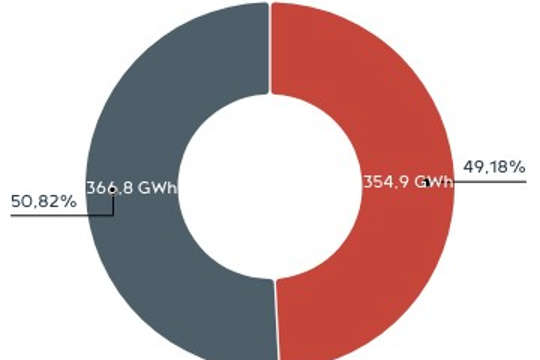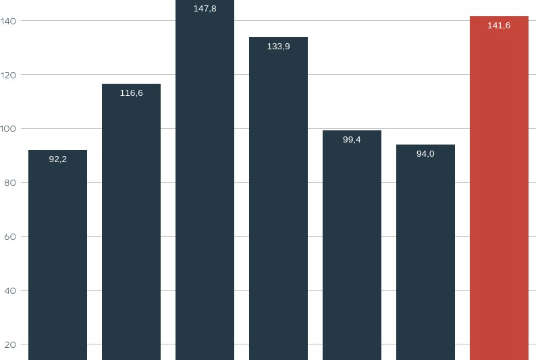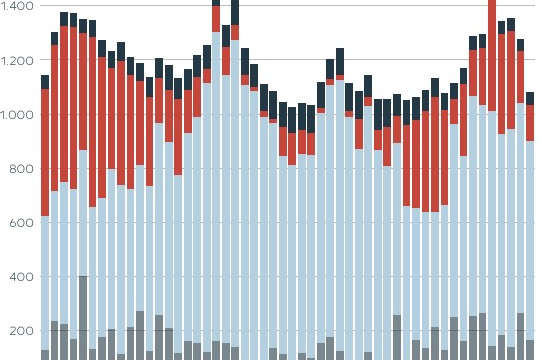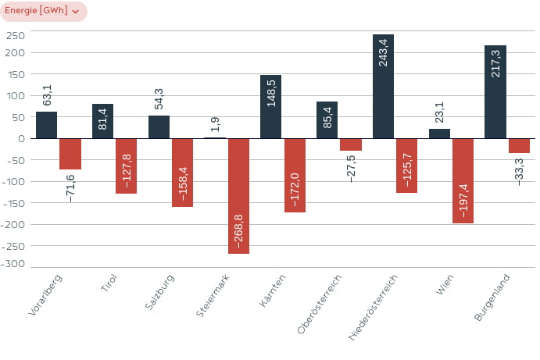A look back at the year 2023 shows which adjustments need to be made for a successful transformation of the energy system and it illustrates why there is no alternative to grid expansion. In addition to an overall system plan which takes into account storage facilities, grids, reserves, production and digital platform technologies in equal measure, the Renewable Energy Directive of the European Union (RED III) as well as the EU Emergency Council Regulation have to be transposed into national legislation to accelerate grid expansion so that it keeps up with the pace of the renewable energy deployment. “The reserves which our grandmothers and grandfathers built into the system have been used up. We have to act now to achieve the targets of the energy transition and to successfully implement the electrification of businesses, industry and society”, says Gerhard Christiner, CTO at APG.
Dynamic growth of renewables entails new challenges
In 2023, a total of 87 percent of the Austrian electricity consumption could be covered with renewable energies. The renewables production in 2023 was 22 percent higher than in 2022 when only 67 percent of the electricity demand could be covered by renewable energies. Compared to the previous year, hydropower increased by 19 percent and wind power by 16 percent. In the calendar weeks 17 to 25 it was even possible to cover 100 percent (on the balance sheet) of the electricity demand with electricity from sustainable energy sources.
Regarding the energy transition, the ongoing expansion of PV systems is also a positive development. By the end of 2023, approximately 2.400 MW from PV facilities were fed into the system, which is equivalent to the output of all power plants along the Danube. However, this development poses major challenges: the increased production from private PV systems causes massive back-feeding of regional electricity surpluses from the distribution grids into APG’s transmission grid. At the same time the coverage of the electricity demand by these private systems results in a loss of data transparency regarding local consumption due to the insufficient degree of digitalization. The usual consumption peak at noon does no longer occur on sunny days: on the contrary, the flow of electricity is completely reversed and the regional electricity surpluses have to be transported elsewhere via the transmission grid. This also significantly changes the electricity price curve and even leads to negative market prices on weekends with low demand.
“The ongoing expansion of PV capacities requires a comprehensive strategy regarding the expansion of grid and storage capacities. Similarly, a comprehensive digitalization of all players in the electricity system is necessary to efficiently manage the system and to handle the volatile renewables,” explains Christiner.
One record after the other regarding electricity exports
Due to good production from renewables through wind power in the "wind strongholds" in the east of the country Austria was able to export electricity very early in 2023. The first “export day” was registered on February 4. In February as a whole 38 percent fewer imports were required than in January. This trend continued throughout the spring and summer. In April Austria was able to be an exporting country for the entire month for the first time since August 2021. In May, electricity exports set one record after another: the daily export volume reached a new historic high of 69.4 GWh on May 10, 2023 (previously: September 2, 2020 with 65.9 GWh), which was surpassed again within a few days on May 11 with 70.3 GWh. With 4,732 MW exports reached a new high on May 17, surpassing the old record of May 2021 (4,484 MW) and climbing to a new record value with 4,995 MW in the night from May 27 to 28. In August, the highest export balance for this month over 20 years was recorded at 520 GWh due to strong hydropower production.
In autumn, the good export situation changed and Austria had to import more electricity which is typical for the season. However, due to a prolonged dry period these imports were particularly high. In October, 32 percent more electricity imports than in the same month in 2022 were recorded, mainly due to low run-of-river production (1,444 GWh). Although wind power increased by 55 percent to 644 GWh compared to 2022, it was not possible to compensate for the shortfall in hydropower production. On balance, 1,064 GWh of electricity had to be imported from abroad.
The very late start of the winter brought a surprising ending in 2023: thanks to good hydropower production, Austria became an electricity exporter again in November for the first time in 16 years (46 GWh). December recorded the lowest import balance since 2011 (194 GWh).
Costs for redispatch measures: increase by 51 percent compared to 2022
With the expansion and increasing integration of renewable energy sources as well as due to the progressing electrification of businesses, industry and society the demands on the grid are continuously increasing. However, the current grid capacities are not sufficient. Redispatch measures are necessary to avoid bottlenecks and ensure a secure supply of electricity at all times. This means a targeted and controlled use of thermal and hydraulic power plants to avoid grid overloads.
“In 2023 interventions in the schedules of power plants were necessary on 217 days to prevent grid overloads. This is apparently a long-term trend, since the average number of redispatch days in the last ten years was 215.9 days,” explains Thomas Karall, CFO at APG.
With 25 days the total number of necessary interventions was particularly high in July, caused by the uncontrolled feed-in of regional electricity surpluses in the transmission grid. This not only entails the risk of incorrect forecasts, but these surpluses must also be taken "out of the system" via the balancing energy market, which is very expensive.
“Redispatching does not only cause higher CO2 emissions but also increased costs, which have to be borne by the electricity customers. In 2023 the total costs for the Austrian electricity customers amounted to 141.6 million euros, which means a 51 percent increase compared to 2022 and almost double the average costs of the past ten years,” emphasizes Karall. Storage power plants accounted for 51 percent (366.8 GWh) and thermal power plants for 49 percent (354.9 GWh) of the redispatch measures.
The expansion of the electricity grid is an essential prerequisite for the availability of affordable electricity. Only if we expand the electricity infrastructure in due time can we succeed in reducing the price difference for Austrian industry and consumers, which in 2023 averaged EUR 6.97 per MWh compared to Germany, for example.
The transmission grid as backbone of a secure energy supply
The trans-regional electricity grid of APG also enables the exchange of energy within the country. Electricity surpluses in individual provinces can thus be distributed throughout Austria to compensate deficits. In 2023 this was particularly important since it allowed the “wind strongholds” Lower Austria and Burgenland to feed their electricity surpluses in windy March (243 GWh and 217 GWh) in the APG grid, while the highly industrial Styria was able to withdraw 269 GWh from it to cover its demand.
APG strengthens grids until 2034 with 9 billion euros
After a thorough analysis of the current problems, APG has planned the necessary investment projects in the context of the Network Development Plan 2023 and will invest around EUR 9 billion in the electricity infrastructure by 2034. The transformer capacity will be almost doubled to 57,000 MVA, the number of substations will be increased by around 39 percent to 90 and the number of transformers by around 74 percent to 165. The entire system of the west-east axis will be strengthened by building, converting or reinforcing around 500 km of 380 kV and around 400 km of 220 kV power lines.
APG calls for an action plan to ensure an affordable energy transition without jeopardizing the security of supply:
- Massive acceleration of approval procedures: Implementation of current amendments to the Austrian Electricity Act (ElWG), Renewable Expansion Acceleration Act (EABG), transposition of RED III into Austrian law
- Establish the Integrated Austrian Network Infrastructure Plan (ÖNIP) as strategic planning instrument with great impact, including a strategic environmental impact assessment
- Comprehensive overall system planning that reconciles production and consumption targets with a storage and grid expansion strategy at all administrative levels
- Investment-promoting regulatory framework with a rate of return that is in line with market conditions
- Standardization of limit values and protection of planned and existing line routes
- Sufficient resources for the authorities (personnel, experts, etc.)
APG continually keeps track of the development of the domestic electricity industry and regularly publishes diagrams at https://www.apg.at/infografiken regarding the topics: energy exchange, energy consumption in Austria, renewables production, import/export, etc.
About Austrian Power Grid (APG)
As independent transmission system operator Austrian Power Grid (APG) is in charge of ensuring the security of electricity supply in Austria. With our high-performance and digital electricity infrastructure and the use of state-of-the-art technologies we integrate renewable energies, we are the platform for the electricity market, and we provide access to reasonably priced electricity for Austria’s consumers and thus create the basis for Austria as supply-secure and future-oriented industrial and business location and place to live. The APG grid totals a length of about 3,500 km and is operated, maintained and continuously adapted to the increasing challenges of the electrification of businesses, industry and society by a team of approximately 850 specialists. 67 substations are distributed all over Austria and the majority is operated remotely from APG’s control center in Vienna’s 10th district. Thanks to our committed employees Austria had a security of supply of 99.99 percent also in 2023 and thus ranks among the top countries worldwide. Our investments of 445 million euros in 2024 (2023: 490 million euros, 2022: 370 million euros) are a motor for the Austrian economy and a crucial factor in reaching Austria’s climate and energy targets. Until 2034 APG will invest a total of approximately 9 billion euros in grid expansion and renovation projects.
Press contact

Carolina Burger





